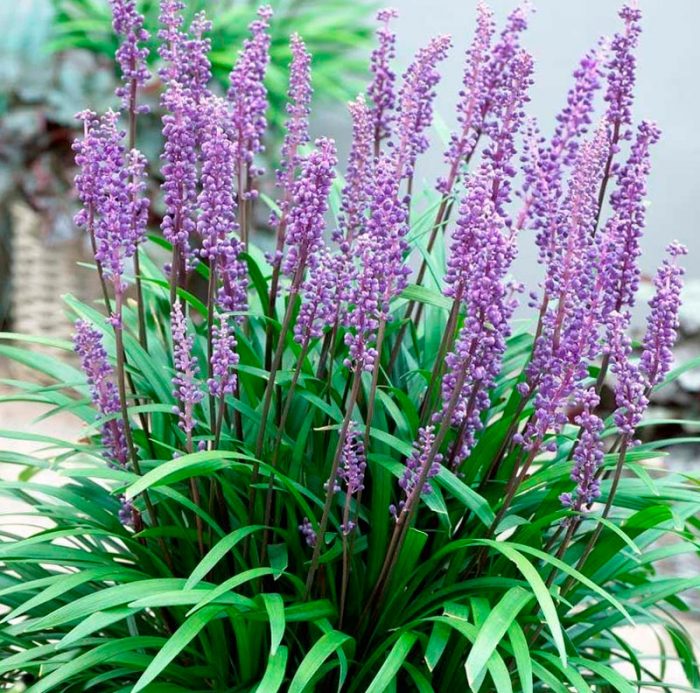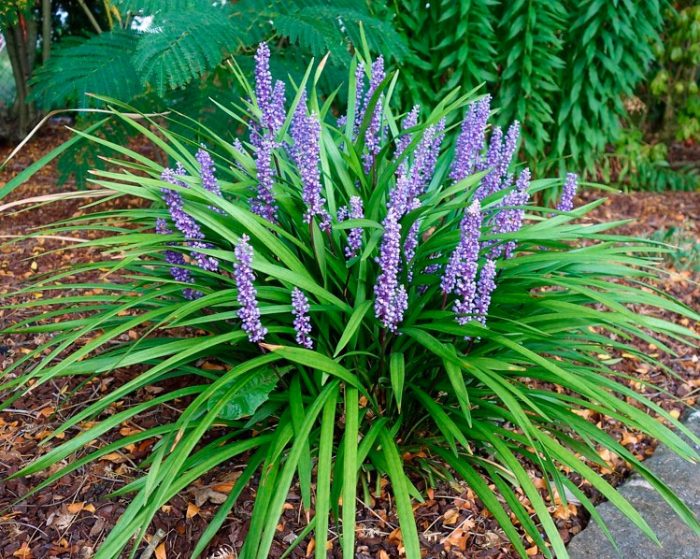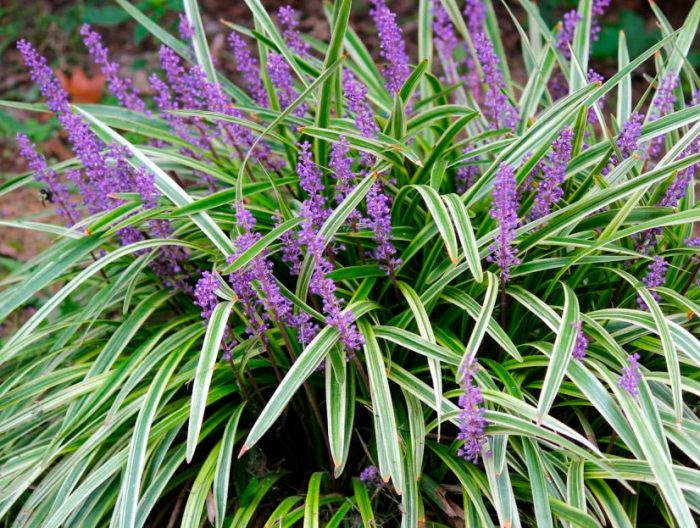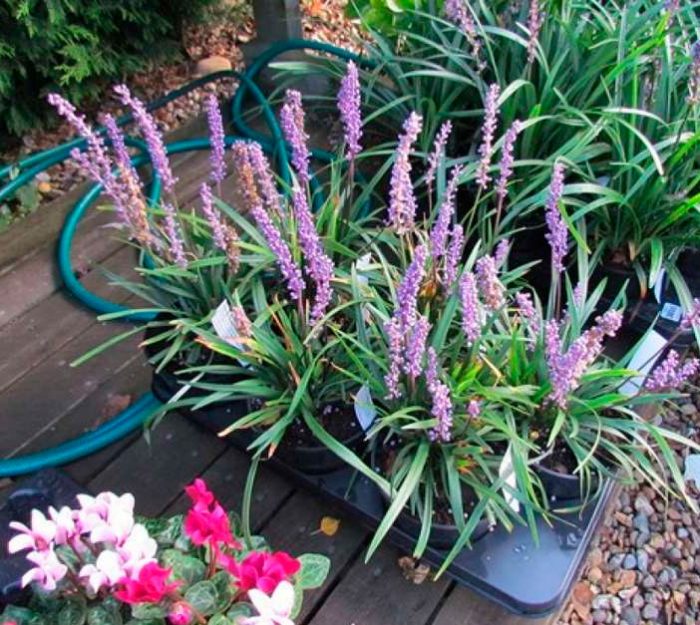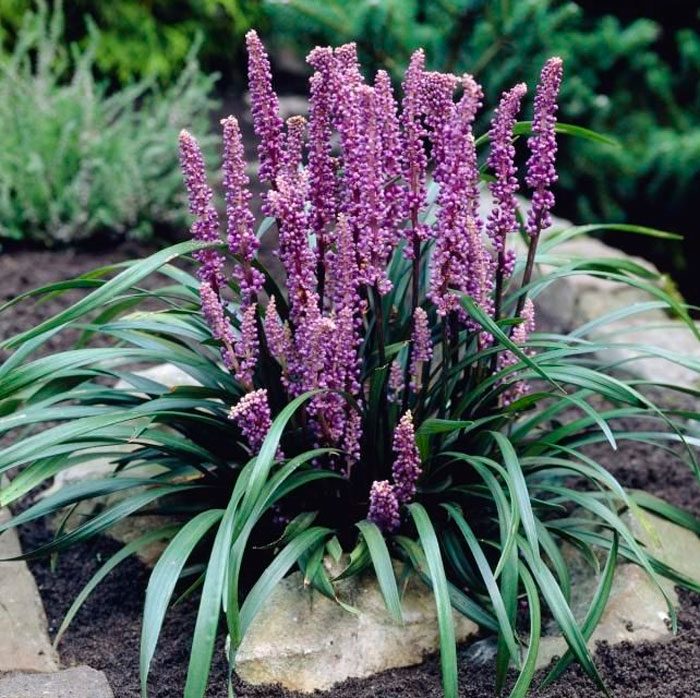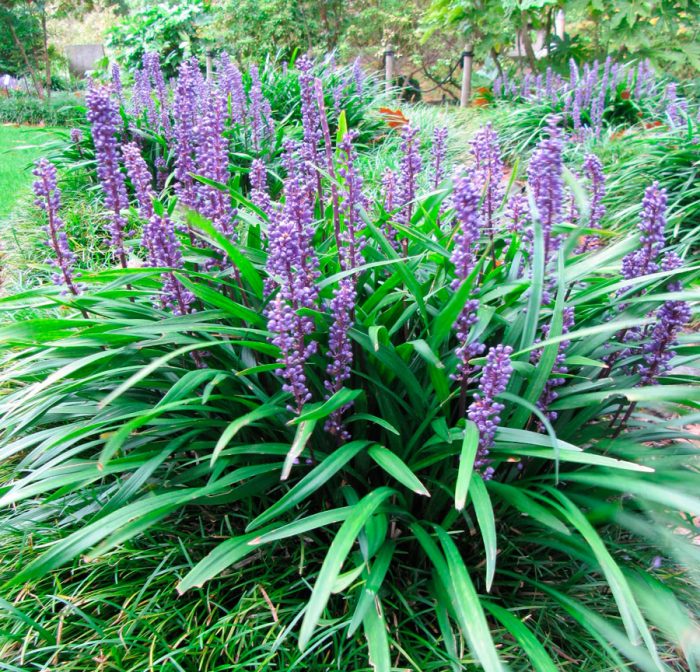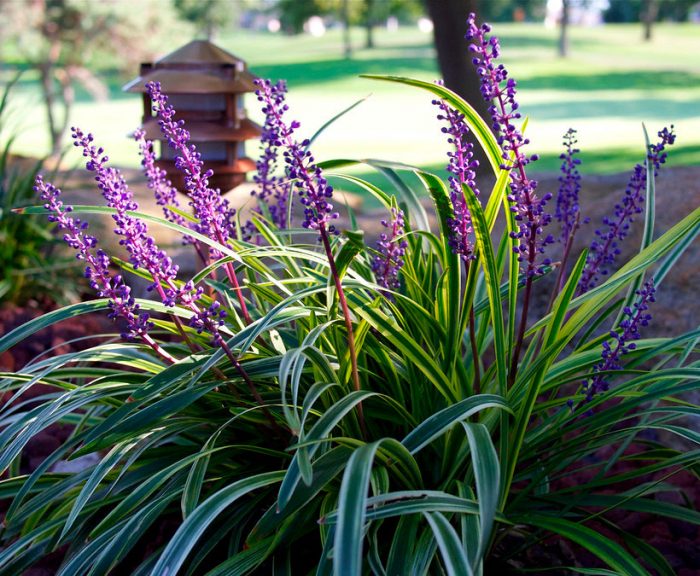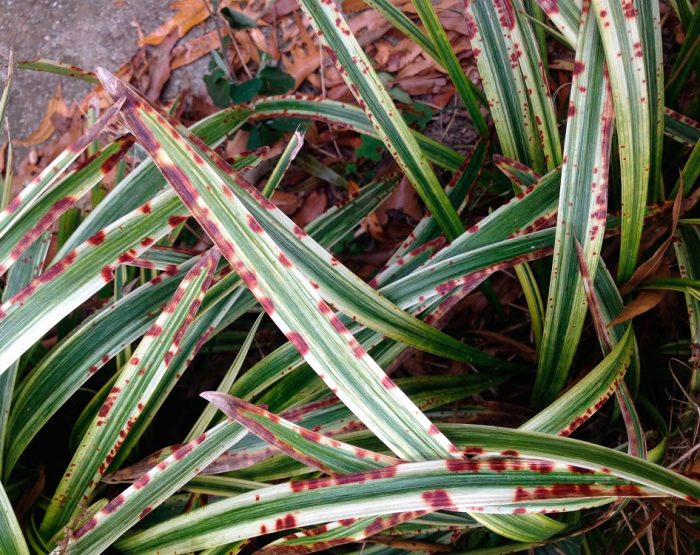Liriope is a large perennial ground cover plant. It is considered part of the Liliaceae family. The rhizome of this ground cover plant is short, and the drooping leaves are oblong and narrow, and they are also slightly curved at the top. Such a plant has no stem. Liriope bushes are medium-sized, they have a height of about 0.7 m. There are also low-growing varieties that reach a height of about 20 centimeters. And undersized varieties are good in that they have dense, spectacular foliage.
The plant is named after the nymph. And this happened due to the fact that its graceful and narrow foliage resembles the figure of a mystical creature. Liriope is grown in the garden as an ornamental showy groundcover. During flowering, the bush is decorated with delicate lilac inflorescences. Thanks to this, such a perennial can become the main decoration of your garden in the fall. This ground cover goes well with all other autumn colors, and therefore it is widely used in landscape design.
Content
Types of lyriope with photos
Liriope Muscari, or Liriope Muscarevidnoe
This species is most popular with gardeners. On the basis of this type, breeders have bred a large number of different varieties and forms. Such a plant has a vertical root system, which consists of roots and small roots, all of which are intertwined. The tough leaves of a dark green color are rather long and have a xiphoid shape. The foliage is either longer than the peduncle, or of the same height. The leaf plates can be decorated with a yellow stripe, which is located in the middle, but this is only observed in some varieties. The length of the whorled peduncle is about 0.7 m, spectacular inflorescences of purple or white color grow on it. This species blooms in autumn.
Liriope spicata, or liriope cereal-leaved
This unpretentious species is quite resistant to frost, which is what most gardeners like. The superficial root system of such a plant is fibrous. Unlike other species of this genus, the leaves of this flower are sinuous. As a rule, the foliage is longer than the peduncles and can reach about 0.4 m, it is painted in a dark green hue and has a xiphoid shape. Outwardly, the leaves of such a plant are very similar to the foliage of cereals.Short stalks can be purple-gray or white. Spike-shaped inflorescences are pale blue in color. Flowering is observed in September – October.
Liriope flat-leaved
Low-growing clumps are overgrown with wide and long leaf plates. Bright greens set off inflorescences. The arrows of the peduncles are short and densely covered with rich blue buds.
Planting and care in the open field
Illumination
Liriope is distinguished by its shade tolerance, so it is recommended to grow it in shaded areas, as well as in the shade of trees and tall shrubs. There are varieties of this ground cover that grow well in sunny areas. The best area for liriope is considered to be one that is fairly well lit, but the light should be diffused. If the lighting is bright enough, then larger inflorescences will form on the bushes, the color of which will also be more saturated. As a rule, in spring, as well as in the first half of autumn, the plant does not have enough sunlight. In this regard, experienced gardeners strongly advise against choosing too shaded areas for planting Liriope.
Seat selection
This plant reacts extremely negatively to drafts. In this regard, for planting it, you should choose a site that has reliable protection from the wind. Light soil is best suited for lyriopa, which is well breathable and rich in nutrients. It can be neutral or slightly acidic.
Landing
Before proceeding with the planting of the culture, they carry out the digging of the site, while sand or compost is introduced into the soil in order to improve its air and water permeability. The fact is that this flower reacts extremely negatively to stagnation of fluid in the root system. In the event that the soil on the site has high acidity, then during digging, a little lime is added to it.
Liriope is planted in pre-prepared small pits, and the distance between them should be about 0.4 m. Such a flower is planted in the garden in early spring.
Watering
Such a flower needs systematic watering, especially during the hot dry season. In the event that the weather is cool in summer, then watering will be sufficient 2 times in 7 days. This plant is drought tolerant and reacts extremely negatively to stagnant liquid in the root system. With regular waterlogging of the soil, rot appears on the roots, and the bush dies. To avoid this, when planting a plant in open ground at the bottom of the hole, it is necessary to make a drainage layer of leaf humus mixed with river sand. In order for the soil to pass water and air better, after each watering its surface should be carefully loosened. Also, such a ground cover reacts well to moisture from a sprayer in the evening, for this they use warm water.
Suitable soil
Light, nutritious soil is best suited for growing lyriope, which should be neutral. When about four weeks remain before planting the bushes in open ground, the site is digged, while river sand and humus should be added to the ground. In the event that the soil is too acidic, then a small amount of lime or wood ash is also added to it.
Transfer
When 3 years have passed after planting Liriope in open ground, it will need to be transplanted. In the event that you neglect this procedure, then over time, the bushes will begin to dry out, and they will also not form inflorescences. This perennial is transplanted in the spring, or rather, in the first days of May. Remove the parent shrub from the soil and divide it into multiple pieces. After that, the delenki are planted in new holes and watered well. Liriope takes root in a new place after about 15 days.
Top dressing
During the growing season, such a flower is fed once every 15 days, for this, both organic and mineral fertilizers are used.Before the bush blooms, it is recommended to use nitrogenous fertilizers to feed it. And it is better to feed a flowering plant with a fertilizer with a high content of phosphorus and potassium.
Flowering features
Such a perennial blooms in autumn. As a rule, flowers appear in September, and the bushes fade around the last days of October. This flower has a rather high peduncle; panicles are formed on them, consisting of small bell-shaped flowers that look like a lily of the valley. Depending on the variety, the flowers can be white, lilac, purple or blue. When the flowers wither, purple seeds form in their place, they can be used for reproduction.
Pruning
Liriope is pruned only so that the bush looks spectacular and neat. To do this, it is necessary to cut off the faded inflorescences in a timely manner, which will provoke the growth of new buds, and also remove the leaves that have begun to turn yellow.
Wintering
Liriope does not need shelter during wintering in the open ground only if in winter there is a lot of snow in this region and there is no severe frost (below minus 15 degrees). In the event that winters are more severe, the plants need to be covered. To do this, they are thrown over with dried foliage, and also covered with a non-woven material on top. After the snow melts with the onset of spring, the shelter must be removed from the bushes.
Reproduction methods
In order to propagate lyriope, you can use the generative (seed) method, as well as the division of the bush.
Growing from seeds
Gardeners rarely grow such a flower from seed, because this method is relatively difficult and time-consuming. For sowing, seeds collected last year are suitable. Sowing is carried out directly into the open ground, and this is done in the first days of May. Seed material is subjected to pre-sowing preparation, for this they are kept in warm water for 24 hours, and then immediately sown. Before sowing, the site is digged, and the necessary fertilizers are applied to the soil. Make not very deep grooves and sow the seeds in them, the distance between them should be about 10 cm. After the seedlings that have appeared get stronger and grow up, they are dived, and all the weak bushes are thrown out. Maintain a distance of about 40 cm between the bushes.
Dividing the bush
By dividing the bush, Liriope is propagated in the first days of May, and this procedure is combined with a transplant. Water the garden bed and dig up a mature plant, after which you can start dividing the bush. Each of the divisions must have a strong root system and at least 10 leaves. After that, the divisions are planted in the pits, which are prepared in advance. In this case, the distance between the bushes should be about 0.45 m. The planted cuttings need watering, after which, if desired, you can cover the surface of the garden with a layer of mulch (dry peat). For a faster rooting of the divisions, they should be fed. Top dressing is carried out regularly for 2 months with a frequency of 1 time in 15 days.
Diseases and pests
Snails, aphids and scale insects can settle on lyriopa. To exterminate them, they resort to treating the bushes with a solution of an insecticidal drug, for example, Actellik (follow the instructions on the package).
Root rot can harm such a plant. This disease can develop due to the regular stagnation of fluid in the roots. If such a problem has arisen, then the diseased bush will need to be transplanted, while cutting out all the rotten areas on the roots from it.
However, most often the plant suffers from improper care. The following problems may arise with it:
- Irregular flowering or no flowering at all... This occurs if the soil on the site is depleted and the bush is lacking nutrients.
- Dried leaf tips... This problem occurs due to irregular watering when the flower does not have enough liquid.
- Loss of stiffness by leaves... The drooping foliage indicates that rot has appeared on the roots due to regular waterlogging.
If you take care of the lyriopa correctly and choose the most suitable site for planting it, then your plant will not get sick, and pests will not settle on it.

